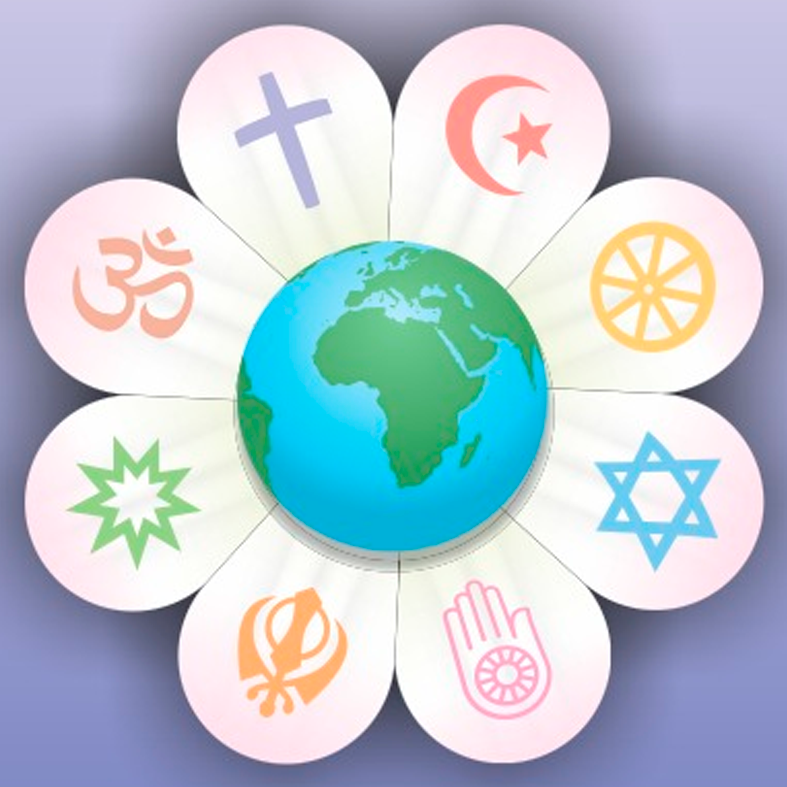
RELIGIÃO
A participação das igrejas nos movimentos migratórios internacionais tem uma longa história. O modelo clássico do papel da religião na vida dos imigrantes formulado nos escritos de Will Herberg e Oscar Handlin, enfatizava a continuidade cultural e os benefícios psicológicos da fé religiosa após o trauma da imigração. Embora essa perspectiva capture um importante aspecto da centralidade da religião nos processos migratórios, o modelo clássico não aborda o papel socioeconômico igualmente importante das igrejas, sinagogas, templos, mesquitas e terreiros – o refúgio da hostilidade e discriminação da sociedade em geral, bem como oportunidades de mobilidade econômica e reconhecimento social.
No caso da emigração brasileira, a partir dos anos 1980, com o aumento do fluxo migratório do Brasil para o exterior, os missionários brasileiros seguiram juntos tentando reparar perdas, inquietações e desamparo, além de levar a palavra do senhor (Ana Cristina Braga Martes, 2000). Essas igrejas atuam também como redes importantes de apoio social e econômico, prestando ajuda nas mais diversas áreas aos membros das suas comunidades. As igrejas pentecostais em particular dispensão atenção maior à ascenção social, claramente expressa na “teologia da prosperidade”, o que em grande parte vai ao encontro de um dos motivos do próprio movimento migratório – melhor condição de vida.
Segundo ainda Martes, as igrejas evangélicas atuam de maneira mais sintonizada com a percepção dos brasileiros, principalmente estes que emigraram para os Estados Unidos, com respeito a cultura americana do individualismo econômico.
Os Estados Unidos tem conhecido uma diminuição crescente da religiosidade entre sua população. O Pew Research Center (2012) relata que “um quinto do público dos EUA – e um terço dos adultos com menos de 30 anos – não têem nenhuma afiliação religiosa.” Vários outros estudos sugerem que 70 por cento dos jovens americanos protestantes abandonam a igreja aos 20 anos (Scott McConnell, 2007).
Para a comunidade religiosa este é um problema crescente pois além dos fatos mencionados acima, a taxa de fertilidade nos EUA estaria abaixo da taxa de reposição da população – pelo menos 2,1 para países desenvolvidos como os Estados Unidos. A taxa atual se mantêm acima deste nível em função da taxa de fertilidade dos imigrantes de 2,9. Juntas, as altas taxas de entrada e natalidade dos imigrantes atuam como contraponto à redução da religiosidade entre os nativos. Assim, matêm-se a possibilidade de um aumento da população cristã nos Estados Unidos, bem como um aumento das muitas outras religiões como o budismo, o hinduísmo e o islamismo. Este fenômeno não se restringe aos Estados Unidos. Pelo contrário, o problema da baixa fertilidade na Europa e Japão são mais graves e na Europa o secularismo é maior que nos Estados Unidos.

Transnational Faiths: Latin-American Immigrants and their Religions in Japan
Hugo Córdova Quero, Rafael Shoji, 2016.
Japan has witnessed the arrival of thousands of immigrants, since the 1990s, from Latin America, especially from Brazil and Peru. Newcomers are having a strong impact in local faith communities and playing an unexpected role in the development of communities.
This book focuses on the role that faith and religious institutions play in the migrants’ process of settlement and integration. Religion is an integral aspect of the displacement and settlement process of immigrants in an increasing multi-ethnic, multicultural and pluri-religious contemporary Japan.
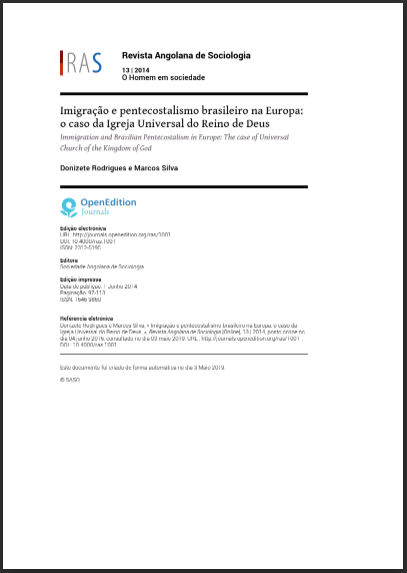
Imigração e Pentecostalismo Brasileiro na Europa: O Caso da Igreja Universal do Reino de Deus
Donizete Rodrigues e Marcos Silva, 2014.
O presente artigo aborda um movimento religioso (neo)pentecostal de base protestante. Em primeiro lugar, a autora caracteriza, embora que brevemente, o Protestantismo e o Pentecostalismo.
O Protestantismo, um dos ramos do Cristianismo, teve o seu início no Século XVI, quando, em 1517, Martinho Lutero (1483-1546) publicou noventa e cinco teses contra algumas doutrinas da Igreja Católica que, rapidamente, se espalharam pela Alemanha, começando assim a Reforma Protestante.
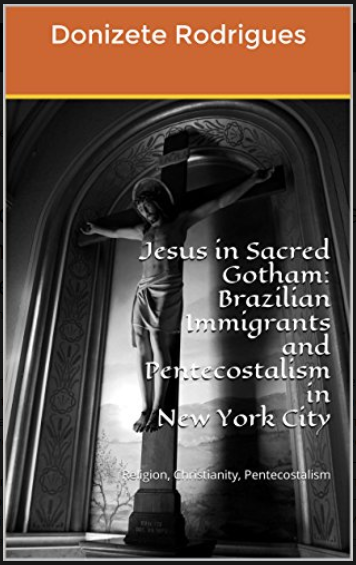
Jesus in Sacred Gotham: Brazilian Immigrants and Pentecostalism in New York City
Donizete Rodrigues, 2014.
From Neo-Pentecostalism emerged in Brazil hundreds (or probably thousands) of new evangelical churches (Chesnut 1997). Since the introduction of the Protestant Neo-Pentecostalism and the Catholic charismatic renewal in Brazil, from the last two decades of the twentieth century, the situation had a radical change; in fact, the situation now is inverted: with the expressive emigration of Brazilians, especially to the United States and Europe has been accompanied by a massive exportation of Brazilian Neo-Pentecostal churches. From the end of the 1980s, many Brazilian churches followed the large Brazilian immigration – mainly to the United States and Europe – began a rapid and expressive international expansion. And as a consequence, today it constitutes an important and global religious phenomenon (Mariz 2009).
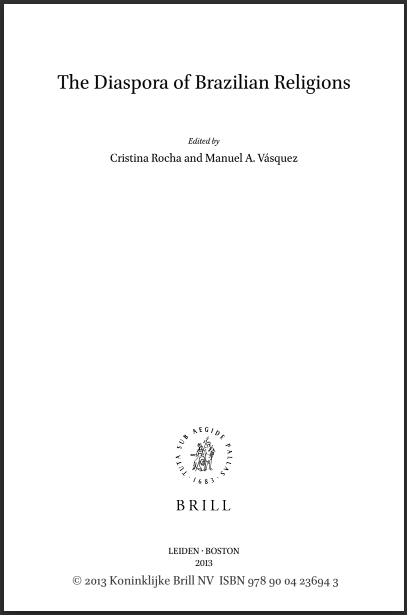
The Diaspora of Brazilian Religions
Cristina Rocha , Manuel A. Vásquez, 2013.
In this introduction, the author sketchs the economic, political, cultural, and religious contexts that have contributed to the recent rise of Brazil as a key center of religious creativity and innovation within an emerging, polycentric global religious cartography.
The reasons for the salience of Brazil in the new global religious cartography are diverse and complex, a mixture of socio-political and cultural processes, which have in the past decade re-inserted Brazil in the global system in a favorable position, operating in conjunction with what has been a historically variegated and dynamic national religious field. Nevertheless, there are identifiable vectors that have contributed to the worldwide construction, diffusion, and consumption of Brazilian religious identities, worldviews, and lifestyles.
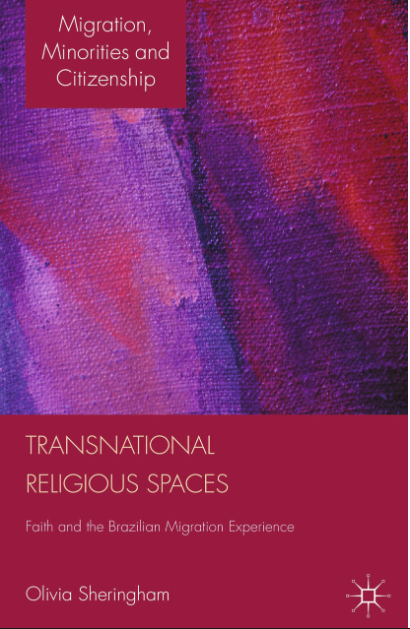
Transnational Religious Spaces: Faith and the Brazilian Migration Experience
Olivia Sheringham, 2013.
This book explores the role of religion in the lives of Brazilian migrants in London and on their return ‘back home’. Working with the notion of religion as lived experience, it moves beyond rigid denominational boundaries and examines how and where religion is practiced in migrants’ everyday lives.
The book focus on two Brazilian religious institutions in London and one in Brazil an scrutinises the different ways in which these spaces provide the means for Brazilian migrants to create a sense of belonging and community in London, to retain connections with their lives back home in Brazil, and to re-adapt to life ‘back home’ on their return.
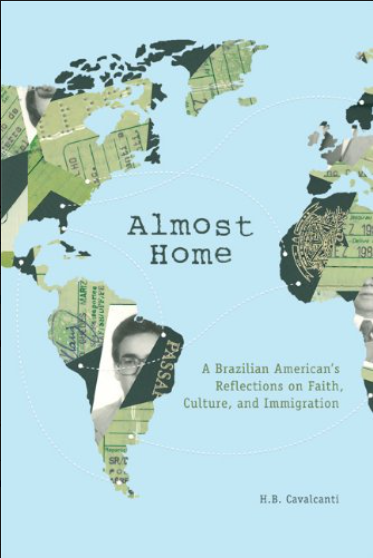
Almost Home: A Brazilian American’s Reflections on Faith, Culture, and Immigration
H. B. Cavalcanti, 2012.
In this book, the author reflects on his life as an immigrant and places his story within the context of the larger history of immigration.
Due to both his family background and the prevalence of U.S. media in Latin America, Cavalcanti already felt immersed in U.S. culture before arriving in Kentucky in 1981 to complete graduate studies.
With its blend of personal anecdotes and scholarly information, Almost Home addresses both individual and policy-related issues to provide a moving portrait of the impact of migration on those who, like Cavalcanti, confront both the wonder and the disorientation inherent in the immigrant experience.
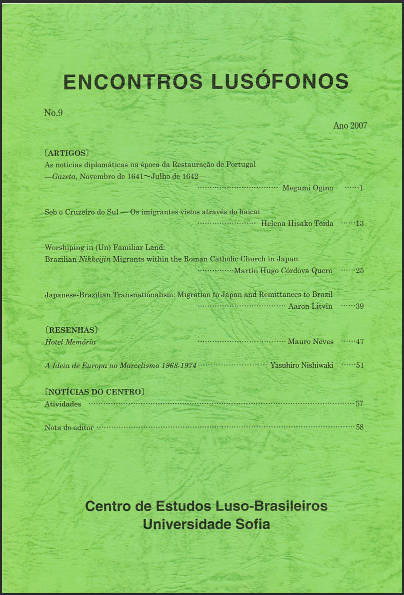
Worshiping in (Un) Familiar Land: Brazilian Nikkeijin Migrants within the Roman Catholic Church in Japan
Martin Hugo Cordova Quero, 2007.
Since 1990 Japan has witnessed the increasing flow of migrants. Among the migrants, those of Japanese ancestry have constituted a particular case. Socio-economic as well as historical processes have been the primary target of academic research on the field. However, very few cases are related to the study of issues of daily life, particularly those related to religion. In those few cases, the goal has been an attempt to map the rich and yet complex world of religion beliefs among the migrants.
The present article seeks to contribute to that task by examining the particular experience of Brazilian Nikkeijin (Japanese descendants born outside Japan) within the Roman Catholic Church in Japan.

Beyond the Ethnic Lens: Locality, Globality, and Born-again Incorporation
Nina Glick Schiller, Ayse Çaglar, 2006.
Migration studies have focused attention on ethnic institutions in global and gateway cities. This ethnic lens distorts migration scholarship, reinforces methodological nationalism, and disregards the role of city scale in shaping migrant pathways of settlement and transnational connection.
To encourage further explorations of nonethnic pathways that may be salient in small-scale cities, we examine born-again Christianity as a means of migrant incorporation locally and transnationally in two small-scale cities, one in the United States and the other in Germany.
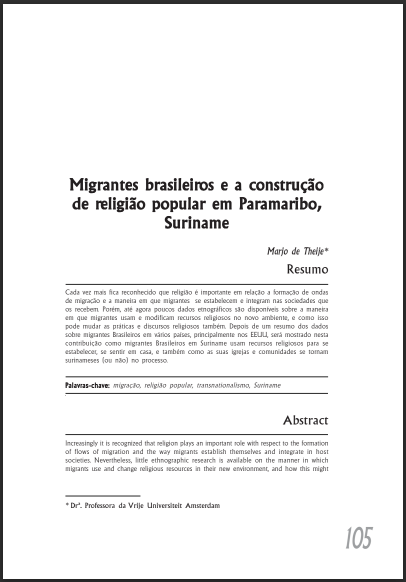
Migrantes Brasileiros e a Construção de Religião Popular em Paramaribo, Suriname
Marjo de Theije, 2005.
Cada vez mais fica reconhecido que religião é importante em relação a formação de ondas de migração e a maneira em que migrantes se estabelecem e integram nas sociedades que os recebem. Porém, até agora poucos dados etnográficos são disponíveis sobre a maneira em que migrantes usam e modificam recursos religiosos no novo ambiente, e como isso pode mudar as práticas e discursos religiosos também. Depois de um resumo dos dados sobre migrantes Brasileiros em vários países, principalmente nos EEUU, será mostrado nesta contribuição como migrantes Brasileiros em Suriname usam recursos religiosos para se estabelecer, se sentir em casa.
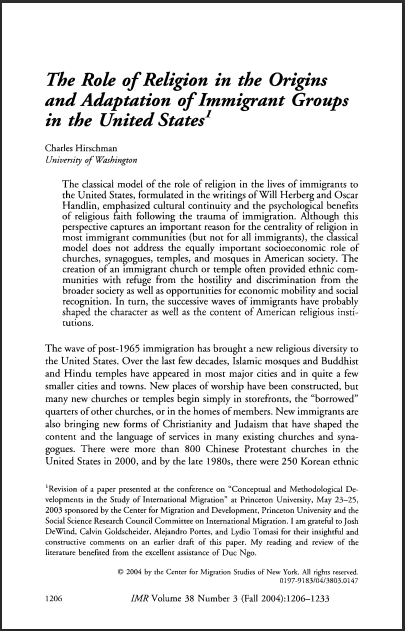
The Role of Religion in the Origins and Adaptation of Immigrant Groups in the United States
Charles Hirschman, 2004.
The classical model of the role of religion in the lives of immigrants to the United States, emphasized cultural continuity and the psychological benefits of religious faith following the trauma of immigration. Although this perspective captures an important reason for the centrality of religion in most immigrant communities, the classical model does not address the equally important socioeconomic role of churches, synagogues, temples, and mosques in American society.
The creation of an immigrant church or temple often provided ethnic communities with refuge from the hostility and discrimination as well as mobility and social recognition. In turn, the successive waves of immigrants have probably shaped the character as well as the content of American religious institutions.
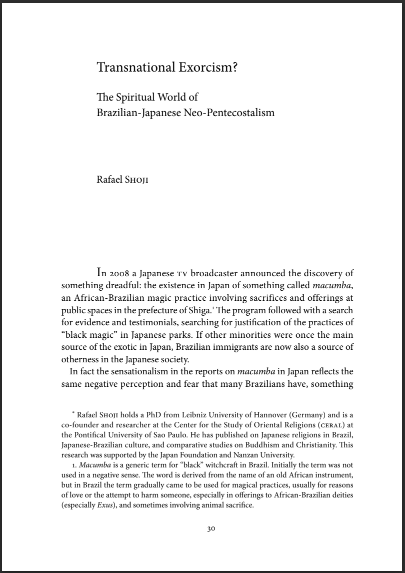
Transnational Exorcism? The Spiritual World of Brazilian-Japanese Neo-Pentecostalism
Rafael Shoji.
The theme of this article is to present an overview of the Brazilian religions in Japan, focusing on the growth of Pentecostalism within the dekasegi community and later to describe in more detail the neo-Pentecostal movement, Universal Church of the Kingdom of God (uckg).
The main focus is on the reinterpretation of Brazilian spiritual world in Japan. In this sense, the author argues that in contrast with the Japanese-Brazilian religions we have in Japan the emergence of a “Brazilian-Japanese” religiosity.
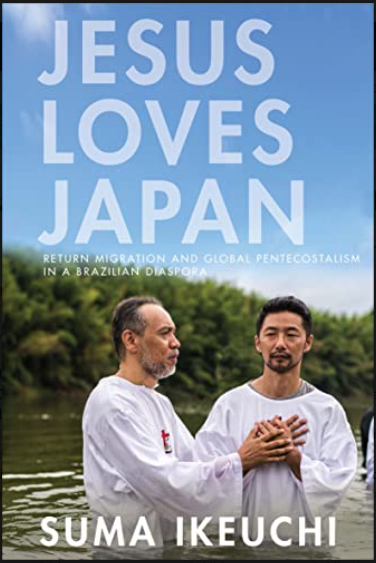
Jesus Loves Japan: Return Migration and Global Pentecostalism in a Brazilian Diaspora
Suma Ikeuchi.
After the introduction of the “long-term resident” visa, the mass-migration of Nikkeis (Japanese Brazilians) has led to roughly 190,000 Brazilian nationals living in Japan. While the ancestry-based visa confers Nikkeis’ right to settlement virtually as a right of blood, their ethnic ambiguity and working-class profile often prevent them from feeling at home in their supposed ethnic homeland.
In response, many have converted to Pentecostalism, reflecting the explosive trend across Latin America since the 1970s. Jesus Loves Japan offers a rare window into lives at the crossroads of return migration and global Pentecostalism. Suma Ikeuchi argues that charismatic Christianity appeals to Nikkei migrants as a “third culture”—one that transcends ethno-national boundaries .
